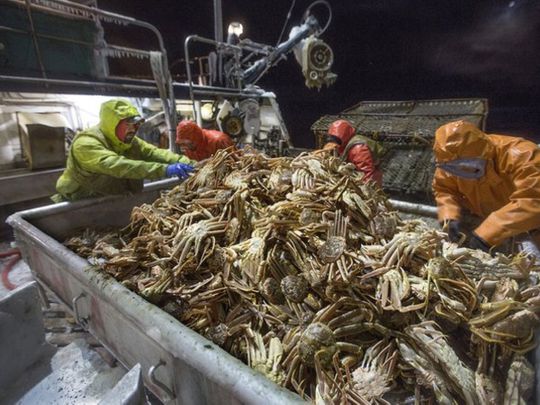
Highlights
- Reasons for crab population collapse not entirely clear.
- The federal government now designates snow crabs as overfished as crab population appears to have crashed.
- The stock of some red king crabs, the largest of the commercially harvested crabs in size, is considered "below the target level" by the NOAA in some waters.
- Last year, Alaska closed king crab season for the first time since the 1990s.
Alaska cancels snow crab season for first time after population collapses But for reasons that are still not entirely clear, the population appears to have crashed. The federal government now designates snow crabs as overfished. The stock of some red king crabs, the largest of the commercially harvested crabs in size, is considered "below the target level" by the NOAA in some waters. Last year, Alaska closed king crab season for the first time since the 1990s.
Alaska will cancel the upcoming winter snow crab season in the Bering Sea for the first time, and bar fishers from catching king crabs in the Bristol Bay for a second consecutive year, because of a sharp decline in their estimated population.
This week's announcements by the Alaska Department of Fish and Game deal a severe blow to fishers that make a living off the crabs.
They also bring back to the forefront questions about the role of climate change in the rapid decline of the snow crab population: The number of juvenile snow crabs was at record highs just a few years ago, before some 90 percent of snow crabs mysteriously disappeared ahead of last season.
This is a major blow to America's seafood industry and could cost the economy $200 million.
Alaskan officials said they had consulted carefully with stakeholders before canceling the season. They said they were aware of the impact of the closures on "harvesters, industry, and communities" but that they had to balance economic needs with conservation.
"These are truly unprecedented and troubling times for Alaska's iconic crab fisheries," said Jamie Goen, executive director of the Alaska Bering Sea Crabbers, a trade association that says it represents some 70 percent of local crab harvesters, in a statement. "Second and third generation crab-fishing families will go out of business due to the lack of meaningful protections by decision-makers to help crab stocks recover."
Alaska's crab fishing industry is worth more than $200 million, according to a report by the Alaska Seafood Marketing Institute, which promotes seafood. The state supplies 6 percent of the world's king, snow, tanner and Dungeness crabs, per the institute.
Male Alaska snow crabs can have a shell width of up to 6 inches. King crabs are much larger, and eating one in a restaurant can cost hundreds of dollars.
The industry is a crucial source of income for many of the 65 communities that make up the Western Alaska Community Development Quota Program, which reserves parts of each year's harvest for remote villages that have limited economic opportunities, The Washington Post previously reported.
For about a decade, the National Oceanic and Atmospheric Administration has documented a continued decline in the estimated population of mature male snow crabs - the only kind allowed to be harvested - in the Bering Sea. But hopes were raised after a record number of juvenile crabs were spotted on the ocean bottom in 2018 and 2019, suggesting a possible boom for future crab seasons.
But for reasons that are still not entirely clear, the population appears to have crashed. The federal government now designates snow crabs as overfished. The stock of some red king crabs, the largest of the commercially harvested crabs in size, is considered "below the target level" by the NOAA in some waters. Last year, Alaska closed king crab season for the first time since the 1990s.
Scientists have expressed suspicion that warmer temperatures in recent years have been responsible. Alaska's summers and oceans have become warmer, scientists say, resulting in a significantly higher seasonal loss of sea ice. The U.S. Environment Protection Agency said in a recent report that rising temperatures may have forced species such as snow crabs further north or into deeper seas.
"In the Bering Sea, Alaska pollock, snow crab, and Pacific halibut have generally shifted away from the coast since the early 1980s," the EPA wrote. "They have also moved northward by an average of 19 miles."
A December 2020 study co-written by Alaska fishing officials also found that the decrease in the geographical size of snow crab habitats could be linked to warming.












